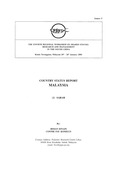Marine fisheries resources status: Sabah report
抄録
A developing country’s economic status is wholly dependent on the optimization and production of its agricultural sector, which includes fisheries. Biusing (1997) reported that the fisheries sector has importance in providing cheap protein (national per capita of 37 kg/year or 60-70% of animal protein consumed) besides offering social economic opportunities to fishermen, downstream processors and traders. In 1998, the total marine fisheries landing (94% of the total fisheries landing) was 196.2 metric tons with a value of RM 660,079 million. This figure shows an increase of 12.5% with a value of RM90,916 million compared to the marine fisheries landing reported in 1997. From 1993 to 1998, the marine fisheries shows a steady and consistent trend of high contribution (93-94%) to the state’s total fisheries production and followed by the aquaculture sector (5-6%) which includes contribution from the freshwater sub-sector. The lowest contribution came from the open water fisheries with yearly production of less than 1%. This report covers the latest status of the marine fisheries sector in Sabah including various issues and recommendations pertaining to the industry.
Suggested Citation
Isnain, I. (2000). Marine fisheries resources status: Sabah report. In Report of the Fourth Regional Workshop on Shared Stocks: Research and Management in the South China Sea (pp. 46-56). Kuala Terengganu, Malaysia: Marine Fishery Resources Development and Management Department, Southeast Asian Fisheries Development Center.

